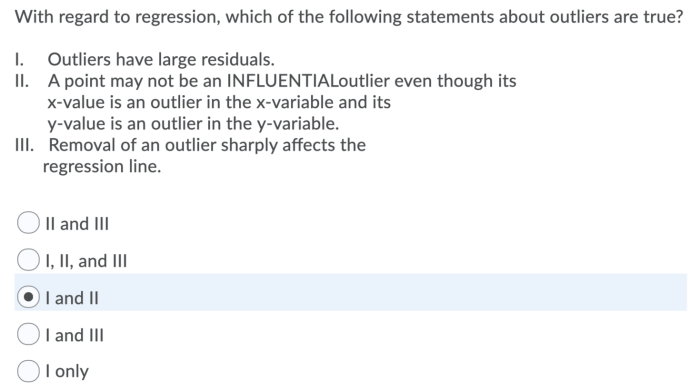Which of the following statements is true for an outlier? Outliers, often regarded as anomalies within a dataset, hold significant implications for data analysis. This article delves into the concept of outliers, exploring their identification, impact, and various approaches to handling them.
Understanding the characteristics and treatment of outliers is crucial for accurate data interpretation and meaningful conclusions.
Outliers can significantly skew results and lead to misleading conclusions, making their identification and appropriate handling essential for reliable data analysis. This article provides a comprehensive overview of outliers, empowering readers with the knowledge to effectively address these data anomalies.
Definition of Outliers
Outliers are data points that significantly differ from the rest of the data set. They are considered extreme values that do not fit the general pattern or distribution of the data.
Outliers can occur in any data set, regardless of the size or type of data. They can be caused by a variety of factors, such as measurement errors, data entry mistakes, or simply the presence of rare or unusual events.
Identifying Outliers

Identifying outliers is an important step in data analysis. It allows us to identify data points that may need further investigation or may require special treatment.
There are a number of different methods for identifying outliers. Some of the most common methods include:
- Z-score:The Z-score is a measure of how many standard deviations a data point is from the mean. Data points with Z-scores greater than 2 or less than -2 are considered outliers.
- Grubbs’ test:Grubbs’ test is a statistical test that can be used to identify outliers. It is based on the assumption that the data is normally distributed.
- Box plots:Box plots are a graphical representation of the distribution of data. Outliers are typically represented as points that fall outside the whiskers of the box plot.
Impact of Outliers

Outliers can have a significant impact on data analysis. They can skew the results of statistical tests and lead to misleading conclusions.
For example, if a data set contains a single outlier that is much larger than the rest of the data, the mean of the data set will be inflated. This can lead to the incorrect conclusion that the data is skewed towards higher values.
Handling Outliers: Which Of The Following Statements Is True For An Outlier
There are a number of different approaches to handling outliers in a data set. The best approach depends on the specific situation and the goals of the data analysis.
Some of the most common approaches to handling outliers include:
- Removing outliers:Removing outliers is the simplest approach to handling them. However, it is important to note that removing outliers can also lead to a loss of information.
- Replacing outliers:Replacing outliers with more representative values is another option. This approach can be used to preserve the information in the data set while still reducing the impact of outliers.
- Transforming outliers:Transforming outliers is a third option for handling them. This approach involves changing the scale or distribution of the data so that the outliers are no longer extreme.
Visualizing Outliers

Visualizing outliers is an important step in data analysis. It allows us to see how outliers are distributed and how they may be affecting the data.
There are a number of different techniques for visualizing outliers. Some of the most common techniques include:
- Box plots:Box plots are a graphical representation of the distribution of data. Outliers are typically represented as points that fall outside the whiskers of the box plot.
- Scatter plots:Scatter plots are a graphical representation of the relationship between two variables. Outliers are typically represented as points that are far from the main trend of the data.
- Residual plots:Residual plots are a graphical representation of the difference between the observed data and the predicted values from a statistical model. Outliers are typically represented as points that are far from the zero line.
Essential FAQs
What is an outlier?
An outlier is a data point that significantly differs from the majority of observations in a dataset.
How can outliers impact data analysis?
Outliers can skew results and lead to misleading conclusions by influencing statistical measures such as mean and standard deviation.
What are some methods for identifying outliers?
Common methods for identifying outliers include using statistical techniques like Z-score and Grubbs’ test, as well as visual techniques such as box plots and scatter plots.
How should outliers be handled?
Approaches to handling outliers include removing them, replacing them with imputed values, or transforming the data to reduce their impact.